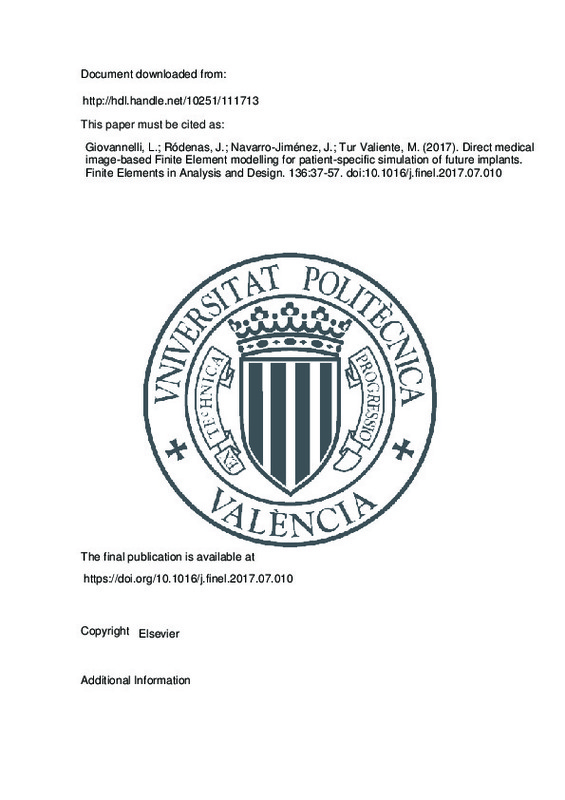JavaScript is disabled for your browser. Some features of this site may not work without it.
Buscar en RiuNet
Listar
Mi cuenta
Estadísticas
Ayuda RiuNet
Admin. UPV
Direct medical image-based Finite Element modelling for patient-specific simulation of future implants
Mostrar el registro sencillo del ítem
Ficheros en el ítem
| dc.contributor.author | Giovannelli, Luca
|
es_ES |
| dc.contributor.author | Ródenas, J.J.
|
es_ES |
| dc.contributor.author | Navarro-Jiménez, J.M.
|
es_ES |
| dc.contributor.author | Tur Valiente, Manuel
|
es_ES |
| dc.date.accessioned | 2018-11-02T05:35:03Z | |
| dc.date.available | 2018-11-02T05:35:03Z | |
| dc.date.issued | 2017 | es_ES |
| dc.identifier.issn | 0168-874X | es_ES |
| dc.identifier.uri | http://hdl.handle.net/10251/111713 | |
| dc.description.abstract | [EN] In patient specific biomedical simulation, the numerical model is usually created after cumbersome, time consuming procedures which often require highly specialized human work and a great amount of man-hours to be carried out. In order to make numerical simulation available for medical practice, it is of primary importance to reduce the cost associated to these procedures by making them automatic. In this paper a method for the automatic creation of Finite Element (FE) models from medical images is presented. This method is based on the use of a hierarchical structure of nested Cartesian grids in which the medical image is immersed. An efficient h-adaptive procedure conforms the FE model to the image characteristics by refining the mesh on the basis of the distribution of elastic properties associated to the pixel values. As a result, a problem with a reasonable number of degrees of freedom is obtained, skipping the geometry creation stage. All the image information is taken into account during the calculation of the element stiffness matrix, therefore it is straightforward to include the material heterogeneity in the simulation. The proposed method is an adapted version of the Cartesian grid Finite Element Method (cgFEM) for the FE analysis of objects defined by images. cgFEM is an immersed boundary method that uses h-adaptive Cartesian meshes non-conforming to the boundary of the object to be analysed. The proposed methodology, used together with the original geometry-based cgFEM, allows prosthesis geometries to be easily introduced in the model providing a useful tool for evaluating the effect of future implants in a preoperative framework. The potential of this kind of technology is presented by mean of an initial implementation in 2D and 3D for linear elasticity problems. | es_ES |
| dc.description.sponsorship | With the support of the European Union Framework Programme (FP7) under grant agreement No. 289361 'Integrating Numerical Simulation and Geometric Design Technology (INSIST)', the Ministerio de Economia y Competitividad of Spain (DPI2010-20542) and the Generalitat Valenciana (PROMETEO/2016/007). | en_EN |
| dc.language | Inglés | es_ES |
| dc.publisher | Elsevier | es_ES |
| dc.relation.ispartof | Finite Elements in Analysis and Design | es_ES |
| dc.rights | Reserva de todos los derechos | es_ES |
| dc.subject | Cartesian grid Finite Element method | es_ES |
| dc.subject | Patient specific modelling | es_ES |
| dc.subject | Implant simulation | es_ES |
| dc.subject | Image based simulation | es_ES |
| dc.subject.classification | INGENIERIA MECANICA | es_ES |
| dc.title | Direct medical image-based Finite Element modelling for patient-specific simulation of future implants | es_ES |
| dc.type | Artículo | es_ES |
| dc.identifier.doi | 10.1016/j.finel.2017.07.010 | es_ES |
| dc.relation.projectID | info:eu-repo/grantAgreement/EC/FP7/289361/EU/Integrating Numerical Simulation and Geometric Design Technology/ | |
| dc.relation.projectID | info:eu-repo/grantAgreement/MICINN//DPI2010-20542/ES/DESARROLLO DE HERRAMIENTA 3D COMPUTACIONALMENTE EFICAZ Y DE ALTA PRECISION PARA ANALISIS Y DISEÑO ESTRUCTURAL BASADA EN MALLADOS CARTESIANOS DE EF INDEPENDIENTES DE GEOMETRIA/ | es_ES |
| dc.relation.projectID | info:eu-repo/grantAgreement/GVA//PROMETEO%2F2016%2F007/ES/Modelado numérico avanzado en ingeniería mecánica/ | es_ES |
| dc.rights.accessRights | Abierto | es_ES |
| dc.contributor.affiliation | Universitat Politècnica de València. Departamento de Ingeniería Mecánica y de Materiales - Departament d'Enginyeria Mecànica i de Materials | es_ES |
| dc.contributor.affiliation | Universitat Politècnica de València. Instituto Universitario Mixto de Biomecánica de Valencia - Institut Universitari Mixt de Biomecànica de València | es_ES |
| dc.description.bibliographicCitation | Giovannelli, L.; Ródenas, J.; Navarro-Jiménez, J.; Tur Valiente, M. (2017). Direct medical image-based Finite Element modelling for patient-specific simulation of future implants. Finite Elements in Analysis and Design. 136:37-57. https://doi.org/10.1016/j.finel.2017.07.010 | es_ES |
| dc.description.accrualMethod | S | es_ES |
| dc.relation.publisherversion | https://doi.org/10.1016/j.finel.2017.07.010 | es_ES |
| dc.description.upvformatpinicio | 37 | es_ES |
| dc.description.upvformatpfin | 57 | es_ES |
| dc.type.version | info:eu-repo/semantics/publishedVersion | es_ES |
| dc.description.volume | 136 | es_ES |
| dc.relation.pasarela | S\342038 | es_ES |
| dc.contributor.funder | Generalitat Valenciana | es_ES |
| dc.contributor.funder | European Commission | es_ES |
| dc.contributor.funder | Ministerio de Ciencia e Innovación | es_ES |







![[Cerrado]](/themes/UPV/images/candado.png)

